-
Countries
-
Data and Analysis
-
Special Focus
-
Crisis Responses
Assessment Report
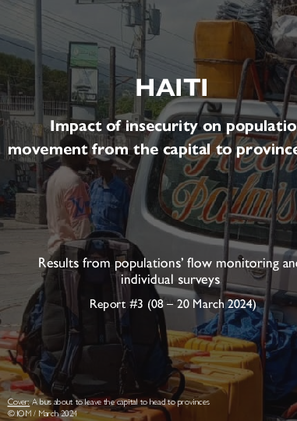
Contact
DTM Haiti, dtmhaiti@iom.int
Language
English
Location
Haiti
Period Covered
Mar 08 2024
Mar 20 2024
Activity
- Survey
- Flow Monitoring Survey
- Flow Monitoring
In recent weeks, armed attacks have intensified in the Metropolitan Area of Port-Au-Prince (MAPAP), the capital of Haiti. In addition to creating displacement within the MAPAP, attacks and generalized insecurity are pushing more and more people to leave the capital to find refuge in provinces, taking the risks of passing through gangs-controlled routes. In order to monitor these movements towards provinces and inform appropriate response strategies, DTM has launched data collection at several of the most used bus stations in the capital (see page 5 for more details on the methodology). Since the start of this activity, on 8 March, until 20 March, this activity allowed to observe the movements of 33,333 people leaving the MAPAP (see pages 3 and 4 for more details on the profile of these people ). The majority of them (62%) took means of transport heading towards the Grand Sud departments (Grande’Anse, South, Nippes and South-East). It should be noted that this region already hosts more than 116,000 people who had in vast majority, fled the MAPAP in recent months (see the report on displacement in the Grand Sud).
It should be emphasized that provinces do not have sufficient infrastructures and host communities do not have sufficient resources that can enable them to cope with these massive displacement flows coming from the capital.
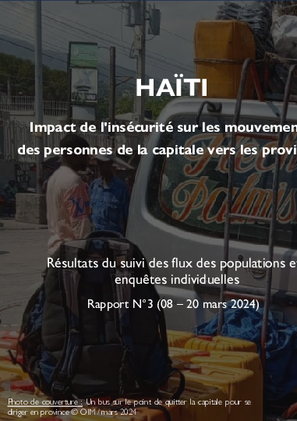
Contact
DTM Haiti, dtmhaiti@iom.int
Language
French
Location
Haiti
Period Covered
Mar 08 2024
Mar 20 2024
Activity
- Survey
- Flow Monitoring Survey
- Flow Monitoring
Depuis quelques semaines, les attaques armées se sont intensifiées dans la Zone Métropolitaine de Port-au-Prince (ZMPP), la capitale d’Haïti. En plus de créer des déplacements à l’intérieur de la ZMPP, les attaques et l’insécurité généralisée poussent de plus en plus de personnes à quitter la capitale pour trouver refuge dans les provinces, en prenant les risques de passer par des routes contrôlées par des gangs. Afin de suivre ces mouvements vers les provinces et informer les stratégies de réponse adéquates, la DTM a lancé des collectes de données au niveau de plusieurs stations de bus les plus utilisées dans la capitale (voir la page 5 pour plus de détails sur la méthodologie). Depuis le début de cette activité, le 08 mars, jusqu’au 20 mars, cette activité a permis d’observer les mouvements de 33 333 personnes quittant la ZMPP (voir les pages 3 et 4 pour plus de détails sur le profil de ces personnes). Ces personnes ont en majorité (62%) pris des moyens de transport se dirigeant vers les départements du Grand Sud (Grande’Anse, Sud, Nippes et Sud-Est). Il est à noter que cette région accueille déjà plus 116 000 personnes qui avaient en grande partie fui la ZMPP durant des mois passés (voir le rapport sur les déplacements dans le Grand Sud).
Il convient de souligner que les provinces n’ont pas suffisamment d’infrastructures et les communautés hôtes n’ont pas de ressources suffisantes qui peuvent leur permettre de faire face à ces flux de déplacements massifs venant de la capitale.
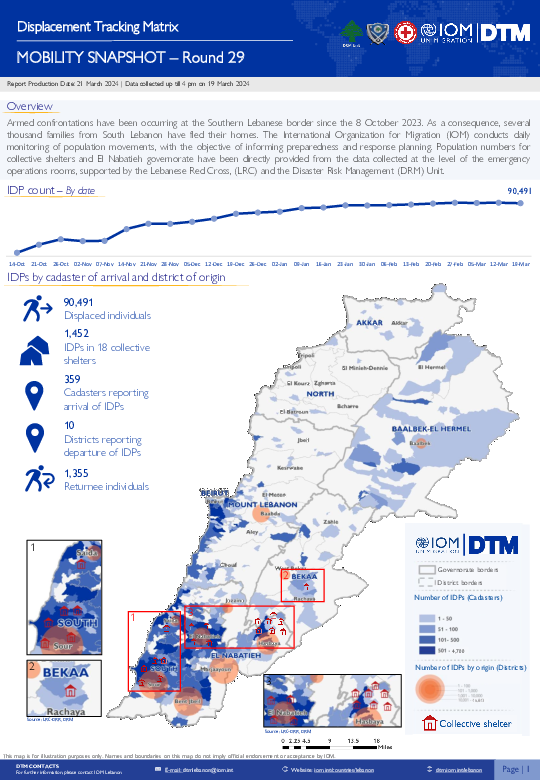
Contact
dtmlebanon@iom.int
Language
English
Location
Lebanon
Period Covered
Oct 10 2023
Mar 19 2024
Activity
- Mobility Tracking
- Baseline Assessment
Since October 8 there has been an increase in cross-border incidents between Israel and Lebanon, resulting in the displacement of people both within the South and elsewhere within the country. Since October 10, the Displacement Tracking Matrix (DTM) has been conducting the daily monitoring of population movements. The objective of the exercise is to inform preparedness and response planning.

Contact
dtmpakistan@iom.int
Language
English
Location
Pakistan
Period Covered
Aug 01 2023
Aug 31 2023
Activity
- Survey
- Mobility Tracking
- Site Assessment
From June to October 2022, storms and heavy monsoon rains in Pakistan caused widespread flooding and landslides across the country. As of 18 November 2022, according to the National Disaster Management Authority (NDMA), up to 33 million people have been affected by the floods and a total of 90 districts have been labelled by the Government of Pakistan as ‘calamity-hit’.
In August 2023, IOM implemented a fourth round of the CNI to provide partners with timely information on the displacement situation, the multisectoral needs of the affected population as well as the recovery needs at the settlement level.11 For this round, IOM implemented the CNI in 11 districts of Sindh. The CNI was conducted in 6,248 flood-affected settlements or settlements that hosted temporary displaced persons (TDPs) across the 11 targeted districts.
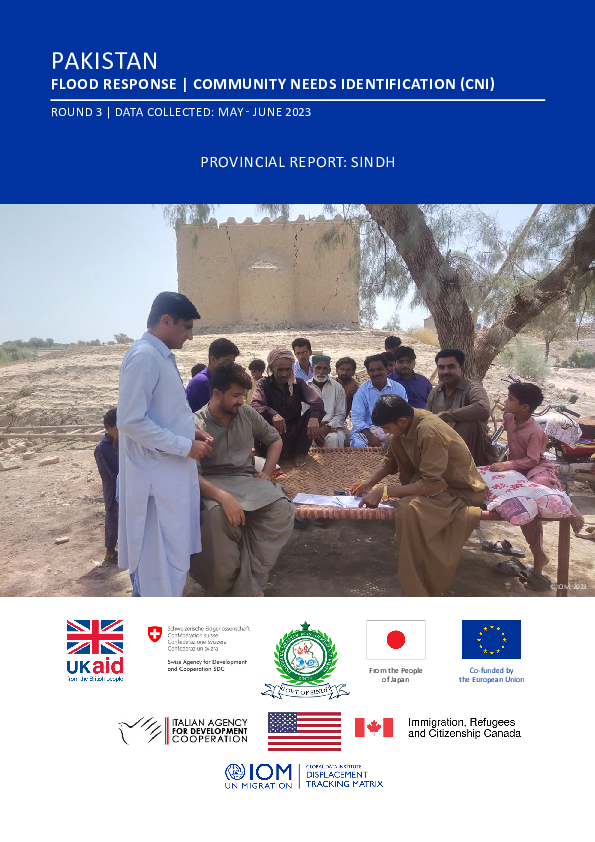
Contact
dtmpakistan@iom.int
Language
English
Location
Pakistan
Period Covered
May 01 2023
Jun 30 2023
Activity
- Survey
- Mobility Tracking
- Site Assessment
From June to October 2022, storms and heavy monsoon rains in Pakistan caused widespread flooding and landslides across the country. As of 18 November 2022, according to the National Disaster Management Authority (NDMA), up to 33 million people have been affected by the floods and a total of 90 districts have been labelled by the Government of Pakistan as ‘calamity-hit’.
Between May and June 2023, IOM implemented a third round of the CNI to provide partners with timely information on the displacement situation, the multisectoral needs of the affected population as well as the recovery needs at the settlement level.11 For this round, IOM implemented the CNI in 11 districts of Sindh. The CNI was conducted in 6,172 flood-affected settlements or settlements that hosted temporary displaced persons (TDPs) across the 11 targeted districts.

Contact
DTMUkraine@iom.int
Language
English
Location
Ukraine
Period Covered
Nov 27 2023
Dec 27 2023
Activity
- Survey
The oblast profiles draw from data in the IOM General Population Survey (GPS) round 15, emphasising population demographics and displacement, durable solutions, shelter adequacy, basic needs, employment & income, and social cohesion. These insights, categorised by population group at the oblast level, aim to support evidence-based decision-making on strategic, technical, and programmatic aspects of the humanitarian response and recovery efforts in Ukraine.

Contact
DTM Europe, DTMMediterranean@iom.int
Language
English
Location
Kosovo 1244
Period Covered
Jul 03 2023
Aug 30 2023
Activity
- Survey
- Flow Monitoring
This report presents the results of the second round of the Displacement Tracking Matrix (DTM) Flow Monitoring Surveys (FMS) collected in Kosovo* from 3 July to 30 August 2023. IOM interviewed a total of 51 individual respondents. The first round of FMS was carried out in June and July 2022. FMS provides a snapshot of the profiles, experiences and needs of migrants residing in Kosovo*. The survey asks questions on demographics, education and employment backgrounds, the circumstances of the migration journey and migration factors, as well as future intentions.
* References to Kosovo shall be understood in the context of United Nations Resolution 1244 (1999).

Contact
DTM Europe, DTMMediterranean@iom.int
Language
English
Location
Republic of Moldova
Period Covered
Jan 01 2023
Dec 31 2023
Activity
- Survey
- Return Intention
Key Findings:
- Out of 8,421 respondents, 92 per cent were planning to return to the same oblast of origin while the remaining 8 per cent aimed to reach a different one. Out of those returning to a different oblast: Kyiv city, Vinnytska and Odeska
- 84 per cent of respondents had crossed back to Ukraine twice or more prior to the survey.
- 58 per cent were already displaced between January and June 2022.
- Respondent's intentions: Short-term visit (56%), Long-term stay (27%), and unknown (17%).
- Main priority needs that were cited by respondents include financial support (34%), medicine and health services (14%) and support with personal safety and security (13%)
- 52 per cent of respondents stated they had no immediate needs.

Contact
DTM Mozambique, DTMMozambique@iom.int
Language
English
Location
Mozambique
Period Covered
Mar 11 2024
Mar 15 2024
Activity
- Other
- Survey
- Return Intention
IOM's Displacement Tracking Matrix (DTM), in collaboration with Mozambique’s Natonal Institute for Disaster Management (INGD) and local authorities in Erati, Nampula, conducted a household-level verication exercise to assess the remaining population displaced by attacks or fear of attacks in Chiure districts, Cabo Delgado. At its peak, Erati hosted over 45,000 internally displaced persons (IDPs) from neighboring Chiure District.
As of March 15, joint verification efforts confirmed the presence of 1,503 IDPs (corresponding to 468 households) still in Namapa and Alua Posto, marking a 70% decrease from the peak between February 19-24. Nacuxa School no longer hosts any families. Children make up 53% of those remaining displaced within the district.
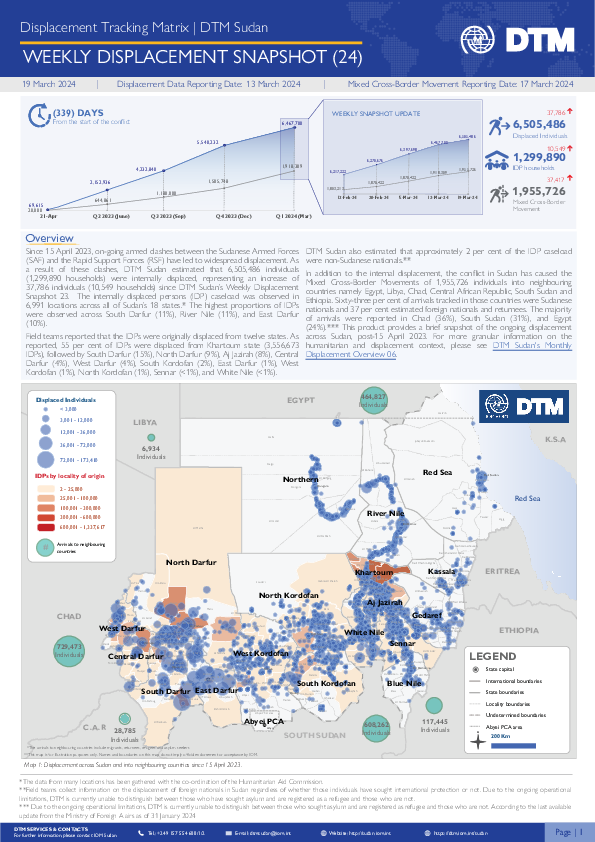
Contact
DTM Sudan; dtmsudan@iom.int
Language
English
Location
Sudan
Period Covered
Mar 08 2024
Mar 13 2024
Activity
- Mobility Tracking
- Baseline Assessment
Overview
On 15 April 2023, armed clashes erupted between the Sudanese Armed Forces (SAF) and the Rapid Support Forces (RSF) in multiple cities across Sudan. Clashes initially took place in cities across Northern and Khartoum states, later spreading across the Darfur and Kordofan regions.
Highlights
- DTM Sudan estimates that 6,505,486 individuals (1,299,890 households) were recently internally displaced.
- The IDP caseload was observed in 6,991 locations across all of Sudan’s 18 states.
- The highest proportions of IDPs were observed across South Darfur (11%), River Nile (11%), and East Darfur (10%).
- Field teams reported that the IDPs observed were originally displaced from twelve states. The majority (3,556,673 IDPs, 55%) were reportedly displaced from Khartoum state; followed by South Darfur (15%), North Darfur (9%), Aj Jazirah (8%), Central Darfur (4%), West Darfur (4%), South Kordofan (2%), East Darfur (1%), West Kordofan (1%), North Kordofan (1%), Sennar (<1%) and White Nile (<1%).
- IOM-DTM also reported that an estimated 1,955,726 mixed cross-border movements were made into neighbouring countries.
- This product provides brief insights into those displaced in Sudan post-15 April 2023. For more granular information on the IDP caseload and the displacement context, please see IOM-DTM's Monthly Displacement Overview 06.
Pagination
- Previous page
- Page 42
- Next page
